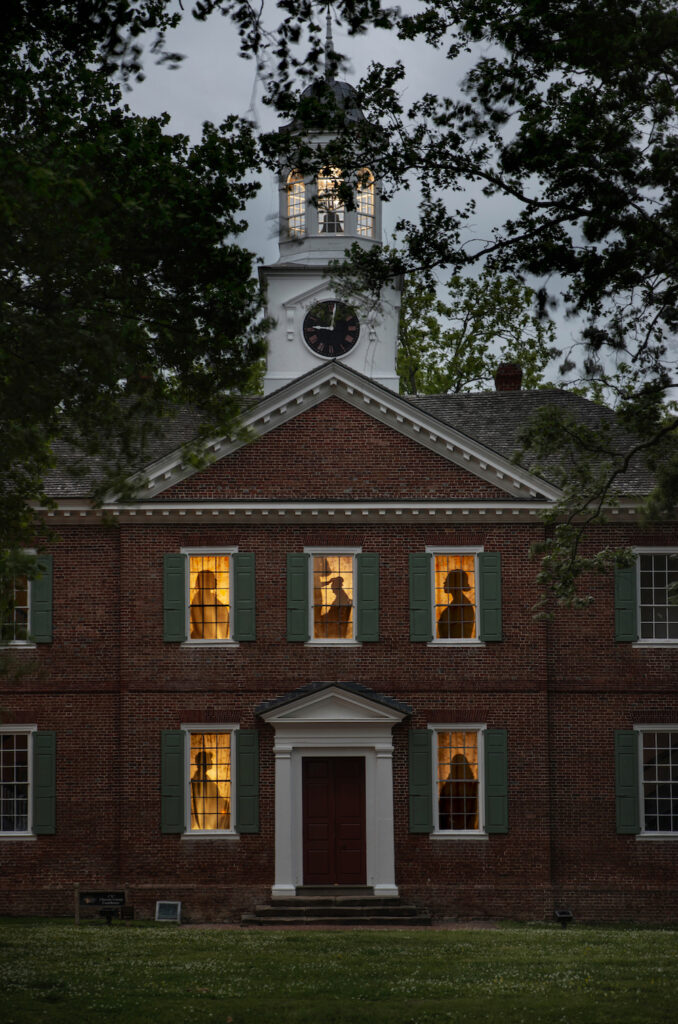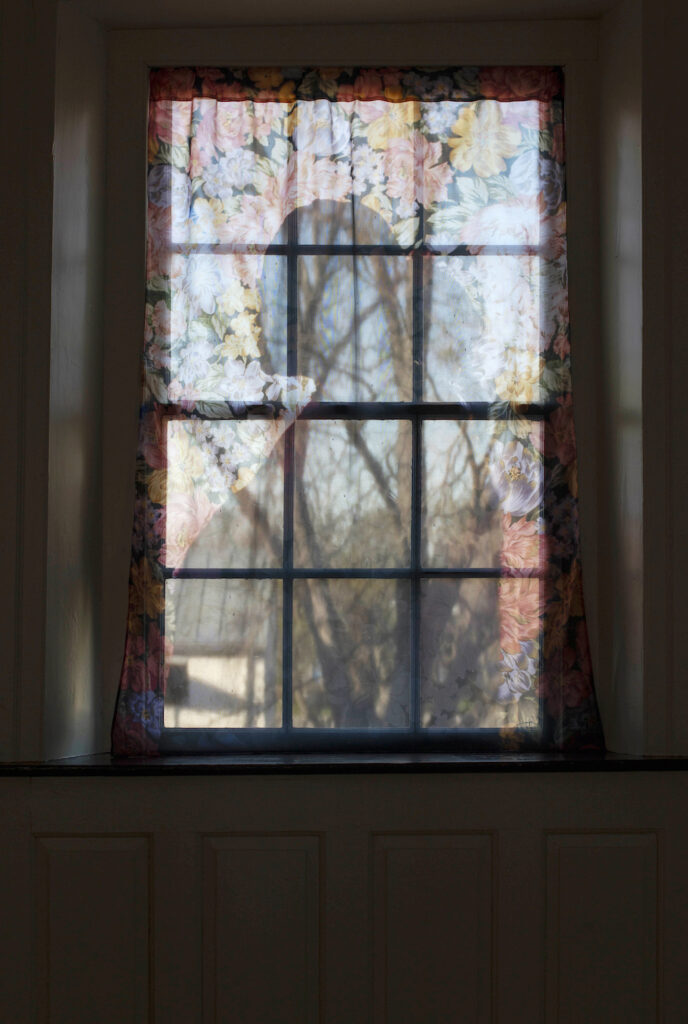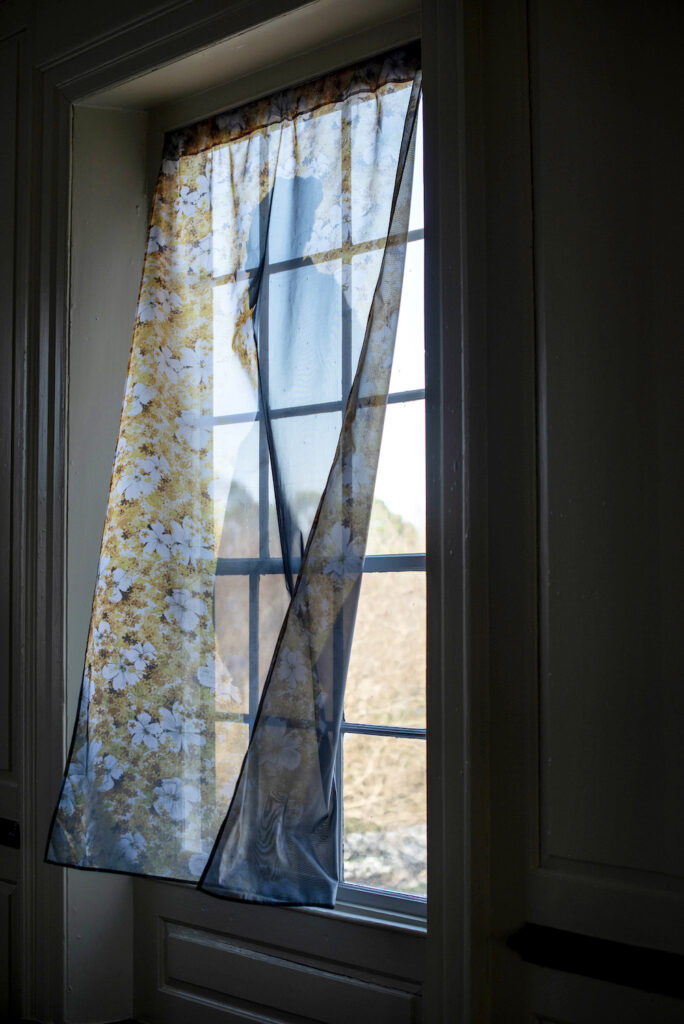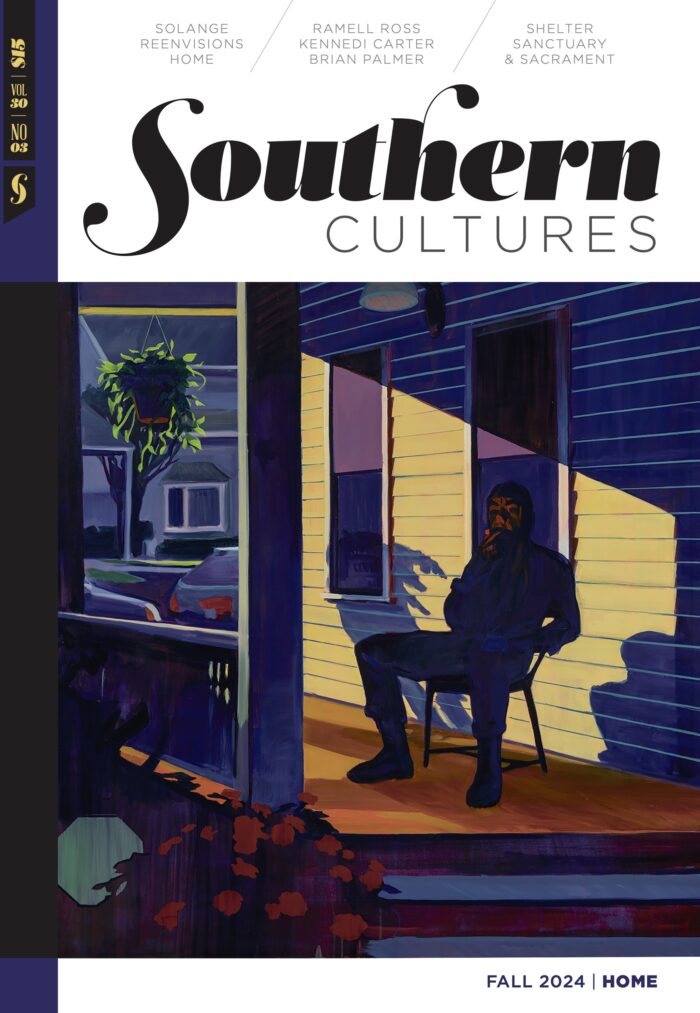The stories of the Black South are infinite. We hear them in music. We read them in literature. They move with and through us in dance. When I consider the practice of Letitia Huckaby, I know too that our stories manifest themselves in the photograph.
Using photographs as objects to be manipulated, Huckaby stitches together these stories anew. These are stories of place—Black southern places—that require us to listen closely to the voices speaking to us from and through the land. And as a storyteller, Huckaby invites viewers of her photographs to consider listening as an active part of any moment of creative encounter. In the quietude of that encounter, entire worlds are revealed, made, and remade.
On the occasion of the opening of her site-responsive installation, Memorable Proof, in Edenton, North Carolina, Huckaby spoke with me about her relationship to image making, how she carries history as an artist, and what she needs to remain spiritually grounded.1
JESSICA LYNNE: Let’s jump in! Can you talk about how Memorable Proof came to life?
LETITIA HUCKABY: Johnica [Rivers] and Michelle [Lanier] invited me to participate. This past summer, I was at a residency in North Carolina. Johnica came and got me from Chapel Hill, and we drove down to Edenton, and I got to see all the spaces that I had been reading about in Incidents in the Life of a Slave Girl.
The location where they would like for me to install work is a historic courthouse. It’s a beautiful building that overlooks the [Albemarle Sound] and it’s in the vicinity of where Harriet Jacobs would have lived and where her grandmother’s house was near to, and the jail right behind it is where her family was held. It’s also the place where her grandmother was able to purchase her own freedom. I ultimately decided to photograph women and girls—young women from Edenton. I went back this past October and stayed for a couple days, and they were able to get a space for me to take portraits and invite women to come. I shot the women in silhouette with different floral patterns.2
Since it’s a historical space, they don’t want you to damage the walls, so I found this company that prints personalized flags. But they’re huge and designed to go outside. They’re four feet by six feet, and the material’s tough because it’s designed to go outside, but it’s voile de ville fabric and a little bit see-through, so the light really pushes through it nicely.
I’m going to get tension rods so the flags won’t damage the windows. I will be dressing fifteen windows in this courthouse. I’ll hang these up in the windows and that way, over the course of the day they’ll look different, and at night if they have the lights on, it’ll glow. From outside you’ll have these silhouetted figures of women. For me, it is very much about us taking, I don’t want to say ownership, but a stance in these spaces where so much was done to Black people. It’s a kind of takeover.
JL: This feels profound, as I think about the silhouettes and how they will be able to take on a heightened sense of reverence, given the different possible encounters a viewer can have.
LH: I hope that it feels that way when people walk through. And then, it still has a feminine quality because of the floral patterns and because the material has a delicate quality to it. And so that’s what we’re thinking about doing. Like I said, I’m using fifteen of the windows. It’s two floors—eight on the bottom floor and seven on the top floor. They’re pretty good-sized windows, so I was just in here debating if I order the flags all exactly the same size, because with old buildings, these windows are all slightly different. Or if I’m going to take the extra step and make them unique to each window.

JL: How did you get your sitters to say yes? Were they excited? Were they nervous?
LH: There was some of both, but really, it was Johnica and Michelle who worked that all out. They told Stella Brothers of the Fannie A. Parker Woman’s Club what I was doing and showed her examples of my work. She invited women of the club and their family and friends to come. We were in a little boutique inn, in one of their foyers, and we didn’t really know how many people were going to show up. I was really surprised to see how many women decided to participate because I have more images than I need for the project. Not everybody’s image is going to be in the courthouse, but I’m giving everyone a print in exchange for participating.3
JL: I want to come back to your work, and I have a question for you about your relationship to the photograph. I know you have a background in journalism, but I’m curious to know what your earliest memories of photography are as a young person, as a child. The longer you work, do you find yourself referring to those early memories of family photos as much as you do, say, some of the more professional instances of encountering the photograph?
LH: I was always obsessed with any pictures of my grandparents or my parents when they were younger, which I’m sure everybody was. To see what they looked like before I knew them, before I even existed, that was always so interesting to me. But when I was in high school, I went to this arts institute in Oklahoma. It’s a place for a lot of different young people in different disciplines to come together. They have intensive summer experiences in many disciplines. I was in dance at the time, but I got to see other young people, let’s say in orchestra or writing or acting. They even had mimes, painting, and drawing. They had photography.
It was all film—there was no digital back then—and it was very magical to see that. It was my first time seeing photography as something other than family portraits, advertising, or the news. These kids were making work that was poetic and personal. They were developing their film and printing it in the darkroom, and they would hang the images out to dry on a line where people could walk by and see them. I just thought it was so amazing and at a certain point, I wanted to quit dance and go into photography. I was getting ready to go to college and my parents were like, “We don’t know if photography is a sustainable form, so we don’t want to pay for an education that you’re not going to be able to support yourself with.” So, I ended up going into journalism because, for me, it was the closest thing to that.
When I graduated, I worked at a radio station in journalism as a promotions coordinator. Because of my position there, I was able to get a discount on classes at the vocational school, where I decided to take photography classes. I took photography, loved it, quit my job, and applied to study under a gentleman whose work I had seen. He was based in Boston, and I had never been to Boston but found a roommate online in the nineties, sold my car so I’d have money to start out with, and just did it. Just moved to Boston, studied photography, and just never looked back, really. I had to pay for that education myself. But now my mom is like, “Okay, I can see it.”
JL: She can see it. She can see it.
LH: I started in documentary work. I really am a bit of a storyteller, but just instead of writing it all down, I use images. That’s what I loved about documentary photography. I started out documenting my personal family, and then it branched out into other people. Currently, I’m invested in lacing Black history into a contemporary experience. What does it look like, thinking about where we’ve come from, the experiences we’ve had, and how much that has really changed or not?
JL: To me, your work navigates layers of conversation about time and place and land. I wonder, how do you contend with that multiplicity when you approach a new project? Is it place that begins the inquiry for you? Is it a question about a ghost that prompts the inquiry? Or is it, perhaps, maybe an image, something that catches your attention that was either previously reported or that you have come across in your own travels that then takes you through the investigation?
LH: I would say place. Place is huge for me. I consider myself a spiritual person, so I feel a connection to the landscape and thinking about people walking that land and the history that’s built into the land. I think about that with fabrics too—the history. I love working with vintage or heirloom fabrics because there’s a history already built into it, and that adds to the conversation.
My mom was a big history buff, and my dad was in the military, so we spent a good bit of time overseas. Her passion was World War II, so when we would go on vacations, we visited concentration camps or the Eagle’s Nest—which was Hitler’s base camp—and saw all this kind of stuff. When I was eleven or twelve years old and starting to recognize art, the first piece of art that really struck me was made by a prisoner in a concentration camp. This person had taken the coal they were supposed to use to warm themselves and drawn some of the other inmates. As a child, I thought, “Okay, I know how cold it gets in Germany. I see the barracks where they’re staying. All they get is a few pieces of coal to warm themselves and for this person, it was important to document this moment and make these portraits of these people.” That struck me, and I think all of that—my mom’s influence, having those experiences, being in the military, and being a kind of “third culture” kid, where you sort of pick up stuff from all over the place—plays into what I’m doing in the work.4
When we’d go in these old churches in Europe, I’d see these monumental paintings of saints or some dignitary and the gravity that artists would give to them. I’m trying to do that with the work that I make—recognizing people that the world doesn’t see in that light, and hopefully doing it in an aesthetic that matches more of our history and culture.

JL: In thinking about the aesthetic traditions that Black folks have globally, but particularly maybe Black southern folks, I know that the manipulation of the photographic image is so much a part of how you work. This is also, for me, connected to place—bringing in traditions of embroidery, quilt making, and the use of cotton as material. What does this material manipulation open for you as compared to more conventional image making?
LH: I started working this way when I was in graduate school. I had just lost my father a couple years before, and he was from Mississippi. The town he was from was a large producer of cotton. There are only two income groups there: very wealthy and stable, and very poor. When you go there, you see that there’s no middle class.
JL: This is Greenwood, Mississippi, right?
LH: This is Greenwood, yes. After he passed, this all hit me, and I started thinking about those things more. I wanted to use cotton in the works specifically because cotton is one of those materials where, when you say it, especially if you’re a person of color, it automatically takes a person’s mind to a certain time in history. For me, to work with cotton is layered no matter what I do.
I first started photographing the cotton like it was a rose, because the plant itself can be very beautiful, and then went in different directions because I was looking at the kind of artwork, let’s say, that my grandmothers were doing when they made quilts or clothes. There was this connection between us through their quilting or dressmaking and my printing images onto those. Or taking their quilt tops that they never finished and printing on top of those. It was a collaborative effort with those who have gone on, those who came before me. The resilience they had with material.
And the beauty of it is when I make pieces with fabric, even though it’s heavily focused on African American culture, it’s so relatable to so many other people because it’s fabric. I get people of all faiths, all ethnic backgrounds, saying, “Oh, I remember my grandmother doing this” or “This reminds me of that.” I made a piece once with a clothesline. It was an installation in an outdoor exhibition series in Dallas that focused on light. We dug up the poles out of one of our neighbor’s yards because they weren’t using them. I had all these sheets and quilt tops and different fabrics with images printed on them. And grown people would run through the clothesline like they were little kids.
I think that’s what fabric does. It brings up these memories and nostalgia for a lot of people. It makes difficult subjects easier to talk about.
JL: That’s a good point. Do you ever worry that there might be stories that you can’t quite tell working in this way? What do you do in those moments?
LH: I am always trying to be respectful because I know the trauma and the pain some of these cultures experience because I’m a Black person myself. For the most part, I’ve always felt really welcomed in the communities, though not everybody wants to participate right away. During my time documenting Wally’s, a jazz club, there was a gentleman who literally said to me, “I’m not interested in participating.” I said, “Okay.” Now I’m hanging out there for weeks on end, and he’s getting to know me and watching me, and eventually he changed his mind.5
The same thing happened in New Orleans when I was photographing a Black order of nuns called the Sisters of the Holy Family. I was photographing the women in the Mother House, which is for the retired nuns in their seventies and eighties. I had a lady walk in and she said, “I’m not participating in that.” I said, “It’s okay. You’re not required. It’s just if you want to.” Thirty minutes later, she came back and sat in the chair and didn’t say anything. I don’t know what happened, I just took the picture and we moved on.6
When I went to do the Greenwood project in Tulsa, the community has a lot of generational trauma from the race massacre. I initially wanted to do portraits, silhouettes of people who were maybe descendants of the original inhabitants of Greenwood, but it felt to me like I would be taking advantage if I pushed that. I ended up switching gears and I tried to feel my way through the project. By feel, I mean feel what’s coming from the people, and also feel what the work is telling me to do. Because sometimes as artists, we can be like, “This is what I’m going to do,” and you stick with that. I’ve seen people who are like this, and they push through the project no matter what happens in the process. I don’t want to be that artist. Once I slow down and listen to what I feel like the project is telling me, then I can shoot in a different direction. That’s what happened in Tulsa, because as I was researching, I found out that the Greenwood in Tulsa has a connection to the Greenwood in Mississippi. I thought, “This is the way I should go. This is my connection to this project.”

JL: This may be related, but it is not quite a process question. What are the things you take with you to spiritually fortify yourself when you’re getting ready to travel to a community? Be it in Fort Worth or Tulsa, Africatown, Greenwood, or even North Carolina. What are the things that you have to have for your artist self but also for Letitia, your spiritually grounded self ?
LH: I usually have something to read. Sometimes it’s related to whatever project I’m working on. Or sometimes it’s African folklore. And I always initially just go with my camera. I use a small rangefinder. I don’t have lots of big lenses. It’s very intimate. I usually go into something slow, and that’s what’s best for me. It’s not good for me to rush a project. In North Carolina, I went there and visited first and just took landscape pictures, listened, and explored. Then, the next time I came back, I was ready to work.
I learned that from documentary photography because these kinds of photographers often work as flies on the wall. They’re watching stories unfold and looking for the image that captures those moments. I still work that way—meditative throughout the whole process—allowing time, space. Even when I went to photograph in Edenton, I made sure to walk. The place where I was staying was right on [Edenton] Bay and there were lots of spaces to walk through fields and along the water. I always take time to get out in nature and move around. That’s like a cleansing for me. I always feel more spiritual, more connected when I’m outside.
JL: I want to ask an important question that has been posed by Michelle, Johnica, and Alexis Pauline Gumbs. You’ve talked about it throughout this interview, but I’d like you to be more pointed. How can Black, southern, and femme cosmographies guide us into the physicality of place, home, space, and possibility?
LH: While I was in Edenton, we visited Hayes, [a former] plantation, which is walking distance from where the courthouse is. This is one of those homes with three and a half floors and balconies on both sides at every level. It has a long tree-lined driveway with roses in front, and it overlooks the water on the back side. They had smaller houses on the property and a coach house where they would keep the stagecoaches. There were five still left in the house. There were busts of historical figures throughout the ages. It was like walking through time.7
After we left there, they asked me, “What did it feel like to go through this space?” I said, “I felt like I shouldn’t be there. It was not made for me.” And Michelle said to me, “Well, when you go through these spaces, I want you to think about the color of the wood. Because when you see the color of the wood, you should think about your skin tone. You should think about how that wood was probably cut down, cleaned, and shaped by Black people.” She said, “You have as much a right to be in that space as anyone else.” And something kind of clicked.
That’s what your question made me think about. There’s all these spaces and places in the South. If you look for Black Freedmen’s towns, many of them are gone, and if they’re left, they’ve been divided by highways. They’ve got manufacturing plants all around them, polluting the air and causing all kinds of sicknesses. These spaces where we were enslaved are designed as historical sites, but they’re not designed to make Black people feel welcome in them as much as they just show the history of what white people acquired. So, the hope is to flip that. That’s why I said these images are like a takeover of the courthouse. It’s a way to put us in these places and spaces that were designed to control us or keep us out. I hope that the work will make Black people feel that when they come inside, or even if they see it from the outside—if it gets the glow I hope it’ll have at night—that it’ll become this monument and marker of the greatness of Black people, not just a place where we were bought and sold or convicted and put in prison.
Letitia Huckaby’s Memorable Proof will be on view at the Center for the Study of the American South this fall and celebrated at the Sojourning issue launch on September 8, 2024.
Letitia Huckaby is an acclaimed photographer who explores Black American heritage, cultural traditions, and faith. Her work is included in the collections of the Library of Congress, the McNay Art Museum, and the Samella Lewis Contemporary Art Collection at Scripps College, among others. She is an assistant professor in the College of Visual Arts and Design at the University of North Texas.
Jessica Lynne is a founding editor of ARTS.BLACK, an online journal of art criticism from Black perspectives; an associate editor at Momus; and host of the Harlem Is Everywhere podcast. Her writing has been featured in publications such as Artforum, The Believer, Frieze, Los Angeles Times, The Nation, and Oxford American.
NOTES
- Organized by Johnica Rivers, curator-at-large of The Harriet Jacobs Project, Memorable Proof is a site-responsive installation documenting members of the Fannie A. Parker Woman’s Club and their extended communities of Edenton, North Carolina, the birthplace and first site of resistance of Harriet Ann Jacobs. The Harriet Jacobs Project is directed by Michelle Lanier, director of North Carolina Historic Sites.
- 1767 Chowan County Courthouse and 1825 Chowan County Jail, 117 E. King Street, Edenton, North Carolina.
- Inner Banks Inn, 103 E. Albemarle, Edenton, North Carolina.
- The Eagle’s Nest, Kehlsteinhaus, 83471 Berchtesgaden, Germany.
- Wally’s Cafe Jazz Club, located at 427 Massachusetts Avenue in Boston, was founded by Joseph L. Walcott in 1947.
- Sisters of the Holy Family Motherhouse, 6901 Chef Menteur Highway, New Orleans.
- Hayes Farm, 1038 Hayes Farm Road, Edenton, North Carolina.


